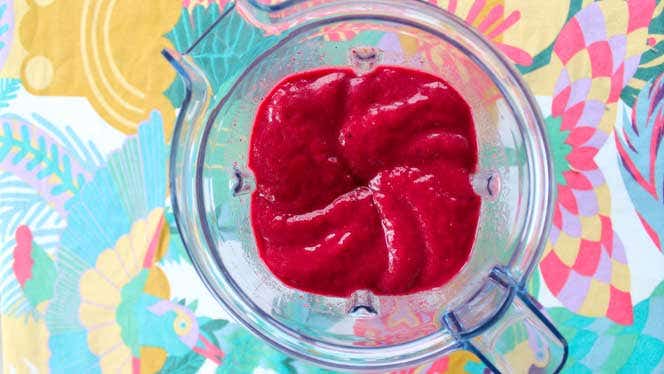
Do You Need a High-Speed Blender? (Plus Shopping and Blending Tips)
Smoothie aficionados and nice cream enthusiasts swear by them, but are high speed blenders really necessary for most plant-based home cooks? After talking to several chefs who have mastered the art of blending, the short answer is yes.
While standard blenders can do most jobs decently well, plant-based recipes often involve whipping up silky sauces, smooth soups, and creamy spreads sans animal products or added fats. Working with fibrous plants or hard nuts requires a little extra power to achieve satisfying textures—something that can be difficult for the standard countertop blender.
“A high-speed blender is the most-used kitchen appliance I own,” says plant-based Chef Katie Simmons, founder of Plants-Rule.com. “I recommend a high-speed blender if you're looking to expand your repertoire of homemade oil-free sauces, soups, dips, and salad dressings.”
These impressive appliances feature higher levels of horsepower than traditional countertop blenders to handle tough tasks. The heftier motors create a stronger vortex at the bottom of the pitcher that makes quick work of blending thick mixtures or crushing ice.
Plus, high-speed blenders typically feature more preset program settings than a standard blender to give you control over the quality of your blend. Forks Over Knives Chef Darshana Thacker recommends taking full advantage of the different speed options to create the texture you want.
“Always start with the slowest speed and then gradually increase it,” Thacker explains. “It’s easy to get impatient and just crank it up to the highest setting. But when you do that, the food can splash all over the inside of the pitcher and not achieve the silky consistency you’re looking for. Slow and steady makes the smoothest texture.”
Another key difference between high-speed blenders and standard ones: the material of the pitcher. Because of their intense power, high-speed blenders feature pitchers made of strong plastic instead of glass so they won’t shatter under pressure.
While traditional blenders can handle the basics, high-speed blenders are an ideal accessory for whole-food, plant-based cooks who want to level up their kitchen expertise.
High-Speed Blender Picks for Every Budget
We asked our whole-food, plant-based experts for the inside scoop on their favorite high-speed blenders and found great options for every budget. Editor's Note: Retail prices are accurate as of the day of publication but may increase or dramatically decrease as sales are announced. Look out for sales!
The Worthy Splurge
Vitamix A2500 Ascent Series Smart Blender | $550 at Vitamix
The holy grail of high speed blenders, the Vitamix A2500 features three program settings (smoothies, hot soups, frozen desserts), 10 speeds, and wireless connectivity that automatically weighs ingredients and adjusts the settings for optimum blending. This 1,380-watt model comes with Vitamix’s signature tamper accessory, which lets you push down and agitate ingredients while the blender is running.
The Mid-Range Workhorse
KitchenAid K400 | $300 at KitchenAid
Chef Katie Simmons uses and recommends Kitchen Aid’s 1,200-watt K400 for its powerful blades and 5-speed variable dial. “I use this for everything—from smoothies in the morning to oil-free vegan ‘cream’ sauces to pureeing soups.” This blender has a 56-oz max liquid capacity and includes a tamper.
Best On a Budget
Ninja Professional Plus BN701 | $120 at Ninja Kitchen
The Ninja Professional Plus BN701’s 64-ounce max capacity pitcher makes blending large batches of soups, smoothies, and nice cream a breeze. Three preset options on this 1,400-watt model help you achieve your desired texture, though really tough items like nuts may take more blending time than they would in a Vitamix.
How to Layer Blender Ingredients
The key to a great smoothie lies in the order you stack the ingredients. Try this expert-approved technique the next time you whip up a plant-powered shake.
- Liquids—such as water, juice, or nut milk—go first. This creates a vortex at the bottom of the pitcher that pulls solid food down to be pulverized.
- Love green smoothies? Your leafy greens and herbs go next. Layering them at the bottom ensures the fibrous leaves will be properly liquefied.
- Fresh fruit, veggies, and soft foods like tofu come next to continue adding volume to the vortex.
- Always add frozen food after fresh ingredients and before the ice so you can adjust the consistency with more liquid if necessary.
- Ice goes last if you like a frosty finish. A thin layer should keep your concoction cold without watering down the flavors.
Blender Cleaning Hack
As soon as you’re done using your blender, fill it ⅓ of the way full with warm water. Add a drop or two of dishwashing liquid and then start to blend on the lowest speed. The sudsy water will pull food debris away from the blades and sides of the pitcher and do most of the cleaning work for you!
Blender Blunders & How to Avoid Them
- Hot Soup Tsunami: Transferring hot ingredients from a pot into your blender can lead to a soupy explosion if you aren’t careful. Steam can build up under the blender’s lid and exert enough pressure that your food goes flying. To avoid this, remove the center insert from the lid and place a dish cloth over the top as you blend to allow the steam to escape.
- The Powder Cloud: If you’re adding powders and spices to your mixture—like cocoa powder or cinnamon—they can escape the blender in a big puff if you aren’t careful. Pour a little liquid over the top of powdery ingredients to tamp them down before you start blending.
- Texture Turmoil: To get an even consistency when you’re blending in batches, be sure to add the same ratio of solids and liquids to the pitcher for each round. If one batch has a lot more liquid than another, the end result might not have the appetizing texture that you’re looking for.

About the Author

About the Author
Megan Edwards
Join our mailing list
Get free recipes and the latest info on living a happy, healthy plant-based lifestyle.
By providing your email address, you consent to receive newsletter emails from Forks Over Knives. We value your privacy and will keep your email address safe. You may unsubscribe from our emails at any time.